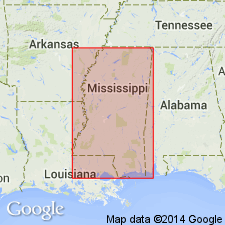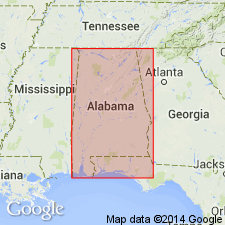
- Usage in publication:
-
- Ferry Lake Formation
- Modifications:
-
- Overview
- AAPG geologic province:
-
- Mid-Gulf Coast basin
Summary:
Ferry Lake Formation is roughly 200 ft of off-white to gray, soft, finely crystalline anhydrite interbedded with gray shales and reddish-brown dense limestones in study area. Conformably overlies the Rodessa Formation and conformably underlies the Mooringsport Formation. Unit is non-productive. Age is Early Cretaceous.
Source: GNU records (USGS DDS-6; Reston GNULEX).

- Usage in publication:
-
- Ferry Lake Anhydrite
- Modifications:
-
- Overview
- AAPG geologic province:
-
- Mid-Gulf Coast basin
Summary:
Report presents five cross sections of the Ferry Lake Anhydrite in AL. Lithology from well cuttings is discussed at length. In well No. 3802, off shore from Mobile Co., the section is dominantly anhydrite, composed of seven beds, three of which are massive. The middle third (46 ft) consists of two massive beds of anhydrite separated by a thin bed of limestone (probably pelecypod, oolitic, ostracod packstone/grainstone). The upper third (54 ft) consists of an 18-foot bed of anhydrite underlain by 38 ft of limestone that is generally mudstone to wackestone and some packstone with traces of ooids, intraclasts, and pelecypod fragments that are partially leached and filled with clear calcite or anhydrite cement. The lowermost 50 ft consists of interbedded limestone and anhydrite. The limestone is primarily an oolitic grainstone containing foraminifers, dasycladacean algae, other green algae, and pelecypod fragments. In AL, unit is restricted to Mobile, Baldwin, and southern Washington Cos, pinching out in southern Washington and northern Baldwin. An isopach shows that the formation thins over the Citronelle dome. Thickness ranges from less than 40 ft in the north to 160 ft near the shore. Anhydrite of the Punta Gorda Formation in FL is equivalent to the Ferry Lake. Overlies Rodessa Formation and underlies Mooringsport Formation. Age is Early Cretaceous--early Albian in Mobile Co., AL, and middle Albian in the MS subsurface as interpreted by Nunnally and Fowler (1954).
Source: GNU records (USGS DDS-6; Reston GNULEX).
For more information, please contact Nancy Stamm, Geologic Names Committee Secretary.
Asterisk (*) indicates published by U.S. Geological Survey authors.
"No current usage" (†) implies that a name has been abandoned or has fallen into disuse. Former usage and, if known, replacement name given in parentheses ( ).
Slash (/) indicates name conflicts with nomenclatural guidelines (CSN, 1933; ACSN, 1961, 1970; NACSN, 1983, 2005, 2021). May be explained within brackets ([ ]).

